
Home - Search - Browse - Alphabetic Index: 0- 1- 2- 3- 4- 5- 6- 7- 8- 9
A- B- C- D- E- F- G- H- I- J- K- L- M- N- O- P- Q- R- S- T- U- V- W- X- Y- Z
Gals
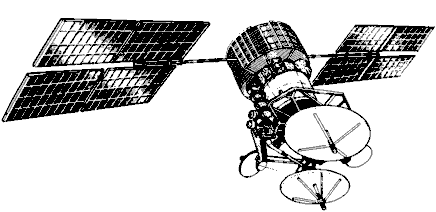
Gals
Credit: USAF Phillips Laboratory
AKA: 17F71. Status: Operational 1994. First Launch: 1994-01-20. Last Launch: 2009-02-11. Number: 15 . Gross mass: 2,500 kg (5,500 lb).
The year 1994 marked the long awaited debut of the first of the next-generation Russian geosynchronous communications satellites. The spacecraft, designed and built by the Applied Mechanics NPO, utilized a new, modernized MSS-2500 class bus with greater electrical power, higher precision station-keeping capabilities (including north-south station-keeping), and longer life. The first of these spacecraft to appear was Gals 1 on 20 January 1994, followed by Express 1 on 13 October. Both employed the MSS-2500-GSO-01 spacecraft bus. Two other models (MSS-2500-GSO-02 and MSS-2500-GSO) were still under development.
The Gals television broadcasting satellite, originally expected to be launched by December, 1990, was designed to support a variety of direct broadcast customers, including professional broadcasting firms (having antenna 2.5 m in diameter), community associations (receiving antenna 1.5 m), and individuals (receiving antenna 0.6-0.9 m). The 2500-kg spacecraft with a payload mass of 420 kg originally were scheduled for deployments at two locations: 230 E with three spacecraft and 44 degrees E with two spacecraft. Later, positions degrees 74 degrees E, 110 degrees E, and 140 degrees E were added. The planned constellation was later altered to consist of spacecraft at 36 degrees E, 56 degrees E, 86 degrees E, 110 degrees E, and 140 degrees E. Two solar arrays with a total power of 2.4 kW supported three Ku-band transponders (one 40 W and two 80 W). The spacecraft bus measured 4.1 m by 6.6 m with a 21-m span across the solar arrays. The design lifetime was 5-7 years. Like most Russian geosynchronous spacecraft, Gals 1 was inserted into the geosynchronous ring near 90 degrees E. A western drift was assigned to permit the vehicle to reach 44 degrees E by early February, 1994. After checkout during which problems were detected with one of the three transponders, Gals 1 was unexpectedly transferred to 71 degrees E in May-June to service, not the Russian Federation, but the PRC and Taiwan. Gals 1 remained at 71 degrees E for the remainder of 1994.
Gals 1 also signaled the first civilian control of a major applications spacecraft. The new Main Control Center at Krasnoyarsk in Siberia of the Applied Mechanics NPO), rather than the military satellite control facility at Golitsino-2, was in charge of Gals l's day-to-day operations. Gals 1 further tested the Russian SPT-100 ion thruster created by the Fakel Bureau. This evaluation program was conducted in conjunction with France's SEP firm and U.S.'s Loral Space Systems Company.
Three modifications of Gals were envisioned. Gals-R would add a fourth transponder and permit zonal (broad area) television broadcasting. The Gals-R6 and Gals-R12 variants would carry 6 and 12 transponders, respectively. The first launch of a Gals-R vehicle was tentatively set for 1996. Two Gals-R class spacecraft were reportedly been ordered by a Chinese company for launches beginning in 1998.
However all of these plans came to nothing and the two Gals launched in 1994-1995 remained the only examples.
More at: Gals.
| Ekspress Russian communications satellite. The Ekspress series communications satellite closely resembled the Gals spacecraft and shared a similar spacecraft bus. Communication satellite built by NPO Prikladnoi Mekhaniki (NPO PM) for RSCC (Kosmicheskiya Svyaz), Russia. Launched 1994 - 1996. |
| Ekspress-A 1, 2, 3 Communication satellite built by NPO Prikladnoi Mekhaniki (NPO PM) (Bus), Alcatel Space (Payload) for RSCC (Kosmicheskiya Svyaz), Russia. Launched 1999 - 2002. |
| Ekspress-AM 22 / SESAT 2 Null |
| Ekspress-AM 11 Communication satellite built by NPO Prikladnoi Mekhaniki (NPO PM) (Bus), Alcatel (Payload) for RSCC (Kosmicheskiya Svyaz), Russia. Launched 2004. |
| Ekspress-AM 1 Communication satellite built by NPO Prikladnoi Mekhaniki (NPO PM) (Bus), NEC (Payload) for RSCC (Kosmicheskiya Svyaz), Russia. Launched 2004. |
| Ekspress-AM 2, 3 Communication satellite built by NPO Prikladnoi Mekhaniki (NPO PM) (Bus), Alcatel (Payload) for RSCC (Kosmicheskiya Svyaz), Russia. Launched 2005. |
| Ekspress-AM 33, 44 Communication satellite built by ISS Reshetnev (ex NPO Prikladnoi Mekhaniki, NPO PM) (Bus), Alcatel (Payload) for RSCC (Kosmicheskiya Svyaz), Russia. Launched 2008 - 2009. |
Family: Communications, Geosynchronous orbit. Country: Russia. Engines: SPT-100. Launch Vehicles: Proton, Proton-K/DM-2, Proton-K/DM-2M, Proton-M/Briz-M. Launch Sites: Baikonur, Baikonur LC81/23, Baikonur LC200/39. Agency: MOM, Reshetnev bureau. Bibliography: 102, 2, 274, 6, 67, 6514, 12472, 12473, 12474, 12475, 12476, 12477, 12478.
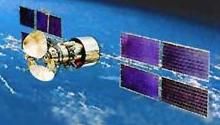 | Gals Credit: NPO PM |
 | Ekspress AM-22 Credit: Manufacturer Image |
 | Ekspress Credit: Manufacturer Image |
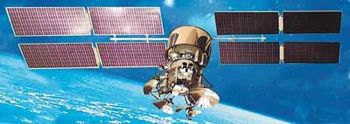 | Ekspress 6A Credit: Manufacturer Image |
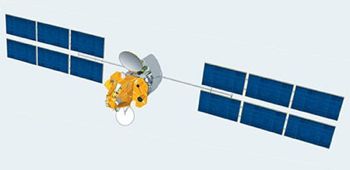 | Ekspress AM-11 Credit: Manufacturer Image |
 | Ekspress AM-33 Credit: Manufacturer Image |
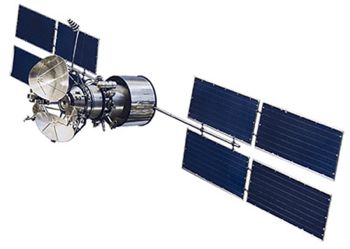 | Gals-2 Credit: Manufacturer Image |
1994 January 20 - . 09:49 GMT - . Launch Site: Baikonur. Launch Complex: Baikonur LC81/23. LV Family: Proton. Launch Vehicle: Proton-K/DM-2M.
- Gals - .
Payload: Gals s/n 11L. Mass: 2,500 kg (5,500 lb). Nation: Russia.
Agency: MOM.
Class: Communications.
Type: Military communications satellite. Spacecraft Bus: KAUR-4.
Spacecraft: Gals.
USAF Sat Cat: 22963 . COSPAR: 1994-002A. Apogee: 36,121 km (22,444 mi). Perigee: 36,121 km (22,444 mi). Inclination: 0.10 deg. Period: 1,453.00 min.
Direct broadcasting satellite (new generation of satellites) intended for development of the Russian television system and international cooperation. Also tested SPT-100 plasma engine. Positioned in geosynchronous orbit at 71 deg E in 1994-1996; 36 deg E in 1996-1999; 42 deg E in 2000. As of 5 September 2001 located at 37.30 deg E drifting at 0.121 deg W per day. As of 2007 Mar 10 located at 67.44E drifting at 0.298E degrees per day.
1994 October 13 - . 16:19 GMT - . Launch Site: Baikonur. Launch Complex: Baikonur LC200/39. LV Family: Proton. Launch Vehicle: Proton-K/DM-2M.
- Ekspress - .
Payload: Ekspress s/n 11L. Mass: 2,500 kg (5,500 lb). Nation: Russia.
Agency: MOM.
Class: Communications.
Type: Civilian communications satellite. Spacecraft Bus: KAUR-4.
Spacecraft: Gals.
USAF Sat Cat: 23319 . COSPAR: 1994-067A. Apogee: 35,935 km (22,328 mi). Perigee: 35,887 km (22,299 mi). Inclination: 1.70 deg. Period: 1,442.40 min.
First launch of new Ekspress communications satellite. Replaces Gorizont series. Ekspress 1 reached its checkout location of 70 degrees E at the end of October 1994 and was moved to its operational position at 14 degrees W shortly after the start of 1995. Stationed at 14.00W in 1995-2001. As of 2007 March 10 located at 95.05E drifting at 1.636W degrees per day.
1995 November 17 - . 14:25 GMT - . Launch Site: Baikonur. Launch Complex: Baikonur LC200/39. LV Family: Proton. Launch Vehicle: Proton-K/DM-2.
- Gals-2 - .
Payload: Gals s/n 12L. Mass: 2,500 kg (5,500 lb). Nation: Russia.
Agency: MOM.
Class: Communications.
Type: Military communications satellite. Spacecraft Bus: KAUR-4.
Spacecraft: Gals.
USAF Sat Cat: 23717 . COSPAR: 1995-063A. Apogee: 35,788 km (22,237 mi). Perigee: 35,784 km (22,235 mi). Inclination: 0.20 deg. Period: 1,436.00 min.
Three transponders for direct broadcast television. Stationed at 70 deg E. Used SPT-100 plasma engine. Positioned in geosynchronous orbit at 71 deg E in 1995-1996; 36 deg E in 1996-1999 As of 5 September 2001 located at 36.88 deg E drifting at 0.031 deg E per day. As of 2007 Mar 10 located at 62.06E drifting at 1.427W degrees per day.
1996 September 26 - . 17:50 GMT - . Launch Site: Baikonur. Launch Complex: Baikonur LC200/39. LV Family: Proton. Launch Vehicle: Proton-K/DM-2M.
- Ekspress No. 12 - . Payload: Ekspress s/n 12L. Mass: 2,500 kg (5,500 lb). Nation: Russia. Agency: AO Infor. Class: Communications. Type: Civilian communications satellite. Spacecraft Bus: KAUR-4. Spacecraft: Gals. USAF Sat Cat: 24435 . COSPAR: 1996-058A. Apogee: 35,809 km (22,250 mi). Perigee: 35,779 km (22,231 mi). Inclination: 3.50 deg. Period: 1,436.50 min. Stationed at 80.0 deg E. Positioned in geosynchronous orbit at 80 deg E in 1996-1999 As of 5 September 2001 located at 103.84 deg E drifting at 0.012 deg W per day. As of 2007 Mar 10 located at 82.98E drifting at 0.225W degrees per day..
1999 October 27 - . 16:16 GMT - . Launch Site: Baikonur. Launch Complex: Baikonur LC200/39. LV Family: Proton. Launch Vehicle: Proton-K/DM-2. FAILURE: Failed early in second-stage burn.. Failed Stage: 2.
- Ekspress-A1 - . Mass: 2,500 kg (5,500 lb). Nation: Russia. Agency: Svyaz. Manufacturer: Reshetnev bureau. Class: Communications. Type: Civilian communications satellite. Spacecraft Bus: KAUR-4. Spacecraft: Gals. Communications satellite; failed to reach orbit..
2000 March 12 - . 04:07 GMT - . Launch Site: Baikonur. Launch Complex: Baikonur LC200/39. LV Family: Proton. Launch Vehicle: Proton-K/DM-2M.
- Ekspress 6A - .
Payload: Ekspress A No. 2. Mass: 2,600 kg (5,700 lb). Nation: Russia.
Agency: Intersputnik.
Manufacturer: Reshetnev bureau.
Class: Communications.
Type: Civilian communications satellite. Spacecraft Bus: KAUR-4.
Spacecraft: Gals.
USAF Sat Cat: 26098 . COSPAR: 2000-013A. Apogee: 35,838 km (22,268 mi). Perigee: 35,736 km (22,205 mi). Inclination: 5.30 deg. Period: 1,436.10 min.
GO Kosmicheskaya Svyaz geosynchronous communications satellite, to be assigned to the Ekspress 6A slot at 80E. Replaced the first Ekspress A, lost in a launch failure in 1999. Russian satellite bus with a ommunications payload from Alcatel France. Stationed at 80 deg E. Positioned in geosynchronous orbit at 80 deg E in 2000. As of 5 September 2001 located at 80.02 deg E drifting at 0.008 deg W per day. As of 2007 Mar 10 located at 102.77E drifting at 0.018W degrees per day.
2000 April 17 - . 21:06 GMT - . Launch Site: Baikonur. Launch Complex: Baikonur LC200/39. LV Family: Proton. Launch Vehicle: Proton-K/DM-2M.
- Sesat - .
Mass: 2,500 kg (5,500 lb). Nation: Europe.
Agency: Eutelsat.
Manufacturer: Reshetnev bureau.
Class: Communications.
Type: Civilian communications satellite. Spacecraft Bus: Gals.
Spacecraft: Ekspress.
USAF Sat Cat: 26243 . COSPAR: 2000-019A. Apogee: 35,802 km (22,246 mi). Perigee: 35,771 km (22,227 mi). Inclination: 0.10 deg. Period: 1,436.10 min.
Sesat (Siberia-Europe Satellite) used an MSS-2500-GSO (Gals/Ekspress) satellite bus built by NPO PM of Krasnoyarsk, with an Alcatel Espace France payload of 18 Ku-band transponders. The satellite had 8 Fakel SPD-100 plasma thrusters for stationkeeping. Eutelsat operated their Hot Bird fleet of European television broadcast satellites since the 1980's, but the venture into broadcasting to Siberia represented a new step for them. Stationed at 36 deg E. Positioned in geosynchronous orbit at 39 deg E in 2000. As of 4 September 2001 located at 35.97 deg E drifting at 0.005 deg E per day. As of 2007 Mar 9 located at 35.92E drifting at 0.004E degrees per day.
2000 June 24 - . 00:28 GMT - . Launch Site: Baikonur. Launch Complex: Baikonur LC200/39. LV Family: Proton. Launch Vehicle: Proton-K/DM-2M.
- Ekspress A No. 3 - .
Payload: Ekspress A3 / Ekspress 3A. Mass: 2,600 kg (5,700 lb). Nation: Russia.
Agency: Intersputnik.
Manufacturer: Reshetnev bureau.
Class: Communications.
Type: Civilian communications satellite. Spacecraft Bus: KAUR-4.
Spacecraft: Gals.
USAF Sat Cat: 26378 . COSPAR: 2000-031A. Apogee: 35,795 km (22,241 mi). Perigee: 35,778 km (22,231 mi). Inclination: 0.00 deg. Period: 1,436.10 min.
Launch delayed from June 23. Geosynchronous communications satellite. Stationed at 11 deg W. Positioned in geosynchronous orbit at 11 deg W in 2000. As of 5 September 2001 located at 10.99 deg W drifting at 0.005 deg W per day. As of 2007 Mar 11 located at 11.00W drifting at 0.005E degrees per day.
2002 June 10 - . 01:14 GMT - . Launch Site: Baikonur. Launch Complex: Baikonur LC200/39. LV Family: Proton. Launch Vehicle: Proton-K/DM-2M.
- Ekspress A1R - .
Payload: Ekspress A No. 4. Mass: 2,600 kg (5,700 lb). Nation: Russia.
Agency: Svyaz.
Manufacturer: Reshetnev bureau.
Class: Communications.
Type: Civilian communications satellite. Spacecraft Bus: KAUR-4.
Spacecraft: Gals.
USAF Sat Cat: 27441 . COSPAR: 2002-029A. Apogee: 35,792 km (22,240 mi). Perigee: 35,776 km (22,230 mi). Inclination: 0.20 deg. Period: 1,436.00 min.
Launch delayed from May 2002. The Ekspress A1R Russian domestic communications satellite was built by NPO PM and Alcatel for Kosmicheskiya Svyaz, the Russian satcom operator. The Proton's parking orbit was off-nominal but the 11S861-01 Blok DM-2M upper stage corrected for this and delivered the payload to the correct orbit. Parking orbit was about 180 x 185 km x 51.6 deg; transfer orbit after the first DM-2M burn was 328 x 36133 km x 47.4 deg; orbit at spacecraft separation was 36102 x 36171 km x 0.2 deg. Two SOZ ullage motors were left in the transfer orbit. As of 2007 Mar 10 located at 14.07W drifting at 0.008W degrees per day.
2003 December 28 - . 23:00 GMT - . Launch Site: Baikonur. Launch Complex: Baikonur LC200/39. LV Family: Proton. Launch Vehicle: Proton-K/DM-2M.
- Ekspress AM-22 - . Mass: 2,542 kg (5,604 lb). Nation: Russia. Class: Communications. Type: Civilian communications satellite. Spacecraft Bus: KAUR-4. Spacecraft: Gals. USAF Sat Cat: 28134 . COSPAR: 2003-060A. Apogee: 35,796 km (22,242 mi). Perigee: 35,778 km (22,231 mi). Inclination: 0.0400 deg. Period: 1,436.11 min. The Ekspress AM-22 communications satellite was built by NPO PM and Alcatel Space for GPKS, the Russian Space Communications Company. As of 2007 Mar 10 located at 52.99E drifting at 0.005W degrees per day..
2004 April 26 - . 20:37 GMT - . Launch Site: Baikonur. Launch Complex: Baikonur LC200/39. LV Family: Proton. Launch Vehicle: Proton-K/DM-2M.
- Ekspress AM-11 - . Mass: 2,542 kg (5,604 lb). Nation: Russia. Agency: Svyaz. Manufacturer: Cannes, Reshetnev bureau. Class: Communications. Type: Civilian communications satellite. Spacecraft Bus: KAUR-4. Spacecraft: Gals. USAF Sat Cat: 28234 . COSPAR: 2004-015A. Apogee: 35,788 km (22,237 mi). Perigee: 35,786 km (22,236 mi). Inclination: 0.10 deg. Period: 1,436.10 min. Delayed from April 10. As of 2007 Mar 10 located at 79.96W drifting at 3.741W degrees per day..
2004 October 29 - . Launch Site: Baikonur. Launch Complex: Baikonur LC200/39. LV Family: Proton. Launch Vehicle: Proton-K/DM-2M.
- Ekspress AM-1 - .
Mass: 2,542 kg (5,604 lb). Nation: Russia.
Agency: ILS.
Class: Communications.
Type: Civilian communications satellite. Spacecraft Bus: KAUR-4.
Spacecraft: Gals.
USAF Sat Cat: 28463 . COSPAR: 2004-043A. Apogee: 35,792 km (22,240 mi). Perigee: 35,783 km (22,234 mi). Inclination: 0.10 deg. Period: 1,436.10 min.
Russian Satellite Communications Company spacecraft, to be stationed at 40 deg E, providing 28 C, Ku, and L band transponders for a wide range of communications and data services. The Ekspress-AM uses an improved Ekspress-M or 727M bus, first used on the Sesat satellite, while the earlier models used the KAUR-4 MSO-2500 bus. As of 2007 Mar 10 located at 39.98E drifting at 0.006W degrees per day.
2005 March 29 - . 22:31 GMT - . Launch Site: Baikonur. Launch Complex: Baikonur LC200/39. LV Family: Proton. Launch Vehicle: Proton-K/DM-2M.
- Ekspress AM-2 - . Mass: 2,600 kg (5,700 lb). Nation: Russia. Agency: Svyaz. Manufacturer: Cannes, Reshetnev bureau. Class: Communications. Type: Civilian communications satellite. Spacecraft Bus: KAUR-4. Spacecraft: Gals. USAF Sat Cat: 28629 . COSPAR: 2005-010A. Apogee: 35,893 km (22,302 mi). Perigee: 35,773 km (22,228 mi). Inclination: 0.10 deg. Period: 1,438.50 min. Delayed from December 2004, then moved up from March 31, 2005. Communications payload of C, Ku and L band transponders. It was to be stationed at 80 deg E. As of 2007 Mar 10 located at 80.01E drifting at 0.008W degrees per day..
2005 June 24 - . 19:41 GMT - . Launch Site: Baikonur. Launch Complex: Baikonur LC200/39. LV Family: Proton. Launch Vehicle: Proton-K/DM-2.
- Ekspress AM-3 - . Payload: Ekspress AM. Mass: 2,600 kg (5,700 lb). Nation: Russia. Agency: Svyaz. Manufacturer: Cannes, Reshetnev bureau. Class: Communications. Type: Civilian communications satellite. Spacecraft Bus: KAUR-4. Spacecraft: Gals. USAF Sat Cat: 28707 . COSPAR: 2005-023A. Apogee: 35,791 km (22,239 mi). Perigee: 35,783 km (22,234 mi). Inclination: 0.00 deg. Period: 1,436.10 min. Delayed from April 2005. Satellite built by NPO PM with Alcatel C-, Ku- and L-band transponders.Stationed over 80 deg E longitude. As of 2007 Mar 11 located at 139.98E drifting at 0.015W degrees per day..
2008 January 28 - . 00:18 GMT - . Launch Site: Baikonur. LV Family: Proton. Launch Vehicle: Proton-M/Briz-M.
- Ekspress AM-33 - . Mass: 2,579 kg (5,685 lb). Nation: Russia. Agency: Svyaz. Manufacturer: Cannes, Reshetnev bureau. Class: Communications. Type: Civilian communications satellite. Spacecraft Bus: KAUR-4. Spacecraft: Gals. USAF Sat Cat: 32478 . COSPAR: 2008-003A. Apogee: 35,795 km (22,241 mi). Perigee: 35,779 km (22,231 mi). Inclination: 0.0300 deg. Period: 1,436.12 min. Stationed at 96.5 degrees east longitude to provide Internet, video, radio, and data services for at a planned 12 year life. The satellite also was earmarked to provide mobile communications for the Russian president and other top government officials..
2009 February 11 - . 00:03 GMT - . Launch Site: Baikonur. Launch Complex: Baikonur LC200/39. LV Family: Proton. Launch Vehicle: Proton-M/Briz-M.
- Ekspress AM-44 - . Mass: 3,672 kg (8,095 lb). Nation: Russia. Class: Communications. Type: Civilian communications satellite. Spacecraft Bus: KAUR-4. Spacecraft: Gals. USAF Sat Cat: 33595 . COSPAR: 2009-007A. Apogee: 35,790 km (22,230 mi). Perigee: 35,783 km (22,234 mi). Inclination: 0.00 deg. Period: 1,436.10 min.
Back to top of page
Home - Search - Browse - Alphabetic Index: 0- 1- 2- 3- 4- 5- 6- 7- 8- 9
A- B- C- D- E- F- G- H- I- J- K- L- M- N- O- P- Q- R- S- T- U- V- W- X- Y- Z
© 1997-2019 Mark Wade - Contact
© / Conditions for Use